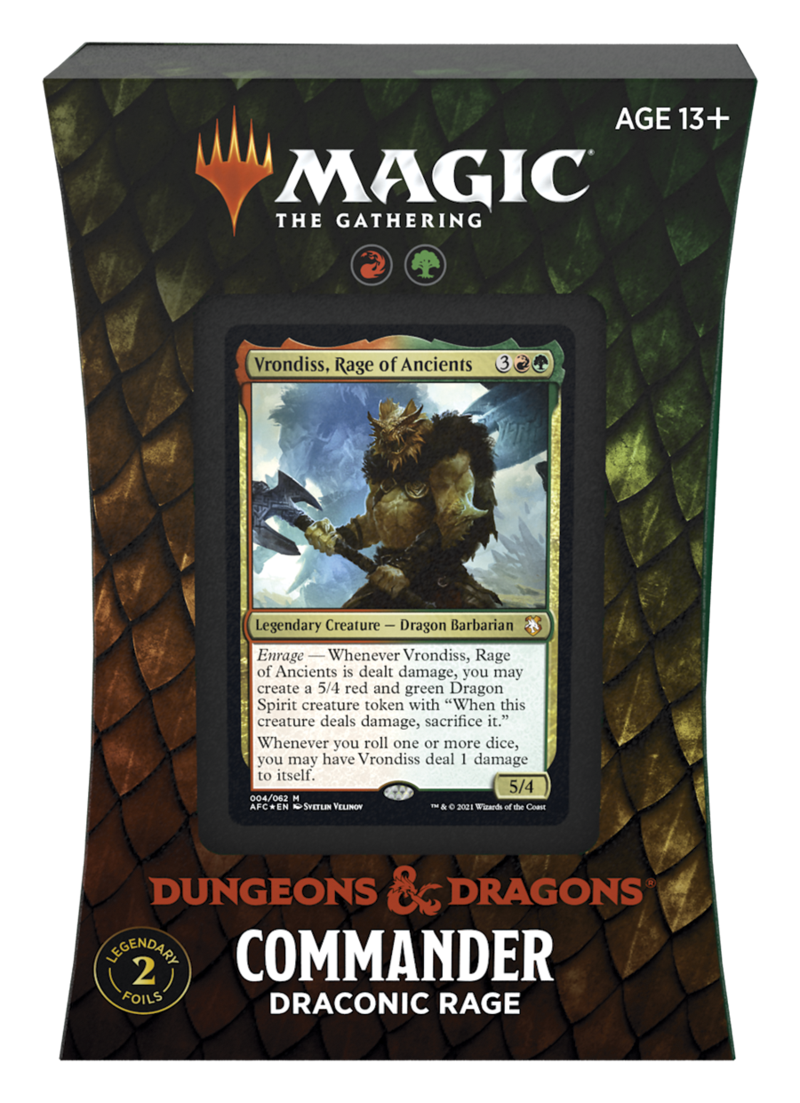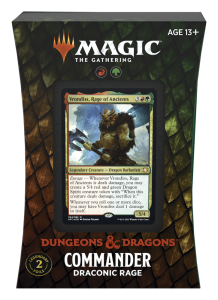This is the comprehensive guide to playing the Draconic Rage precon, commanded by Vrondiss, Rage of Ancients!Vrondiss, Rage of Ancients! This guide contains all the information needed to ride Draconic Rage to victory straight out of the box!
Draconic Rage is interested in just one thing: flooding the board with dragons and dishing out large, lethal attacks to its opponents.
This is not a flashy deck by any means, and it mostly revolves around pure stats, jamming power and toughness onto the board, and taking advantage of its large creatures (which are mostly dragons) to stay ahead on cards. Vrondiss plays more of a supporting role in this deck than the other Adventures in the Forgotten Realms precon commanders. He certainly helps the deck’s strategy and can create multiple giant beaters with his Enrage ability, but the deck can easily function without him.
Surprisingly for a Gruul deck, one of the primary strengths of Draconic Rage is its abundance of card advantage.
- This deck has a high number of permanents that allow for repeatable card draw. Garruk’s UprisingGarruk’s Uprising works perfectly with Vrondiss, and granting trample means dealing extra damage by eliminating the possibility of chump blocking from opponents. Dragon’s HoardDragon’s Hoard will get counters faster than they can be removed while doubling as mana ramp. It’s one of the best payoffs for the dragon tribal theme of the deck. Commander newcomer Dragonborn ChampionDragonborn Champion makes pushing through damage that much more brutal for opponents, but rarely enters combat itself.
- There are also spells that add large bursts of cards in the form of Rishkar’s ExpertiseRishkar’s Expertise, which requires one large creature to have a massive impact, and Shamanic RevelationShamanic Revelation, which needs at least 3 creatures to be worth casting. These can seal away games virtually by themselves in the later turns. Return of the WildspeakerReturn of the Wildspeaker pulls double duty by either pumping the deck’s dragon army or completely refueling its hand with basically any one dragon in play.
- Lastly, there are the upkeep trigger permanents. Colossal MajestyColossal Majesty requires a board presence for it to draw a card, but Outpost SiegeOutpost Siege guarantees a card, and the “Dragons” mode of the card is one the deck will choose frequently, since it can trigger Vrondiss, Rage of AncientsVrondiss, Rage of Ancients’s Enrage ability multiple times.
The other strength of this deck is that it has no shortage of reliable win conditions. It will almost never have to dig to find one, and will have plenty of replacements if an important attacker is removed. All of these cards can put away games or kill multiple players reliably alongside a respectable boardstate.
- Scourge of ValkasScourge of Valkas is the ultimate Dragon payoff, and only requires a few dragons in play before it can start destroying players’ life totals. Warstorm SurgeWarstorm Surge functions similarly, and every small creature played is still worth five damage with Vrondiss out. It should be noted that when a 5/4 Dragon token enters, Warstorm SurgeWarstorm Surge will cause it to be sacrificed after damage is dealt, but Scourge of ValkasScourge of Valkas will not. Kindred SummonsKindred Summons plays into the tribal theme, but requires a solid boardstate to begin with. But, when coupled with a haste enabler like AngerAnger, or even a leveled up Barbarian ClassBarbarian Class, it can be the strongest play in the deck.
- Gratuitous ViolenceGratuitous Violence, Terror of Mount VelusTerror of Mount Velus, and Atarka, World RenderAtarka, World Render all read slightly differently but essentially double the damage output of this deck’s entire team, leading to surprise kills that will leave opponents regretting their blocking decisions.
- Klauth, Unrivaled AncientKlauth, Unrivaled Ancient rewards the deck heavily for assembling a large attack, putting potentially dozens of mana into the pool for a flurry of damage-dealing spells in the second main phase.
Despite those impressive strengths, the deck does have a few weaknesses. One such weakness is the aforementioned lack of support for Vrondiss’s Enrage ability. His die-rolling trigger can often feel like flavor text, and doesn’t come up very often. The deck has 10 cards that can roll dice, but some of them are expensive, difficult to time correctly, or don’t work well with Vrondiss.
The second weakness stems partly from the strength of this deck. With Draconic Rage packed to the brim with large dragons, high-power creatures, and flashy enchantments, very little room is left for one or two drop plays. The average mana value of spells in Draconic Rage is a whopping 3.97 mana, so it will be hard for this deck to double spell consistently.
Despite its clunky nature, Draconic Rage can still function and achieve its goals and win conditions. Two cards in the deck can help offset the deck’s early game inactivity: Druid of PurificationDruid of Purification and Klauth’s WillKlauth’s Will.
These are arguably the two best Commander cards from any of the four Adventures in the Forgotten Realms precons. They’re extremely efficient, and it’s worth noting that any opening hand containing these cards can afford to start the game out a little slower. They remove a high number of permanents relative to their mana costs, and are the best individual cards in the deck.
On the opposite end of the power spectrum come the deck’s worst cards; the cards to deploy last or sometimes not bother deploying at all.
- Earth-Cult ElementalEarth-Cult Elemental is so close to a vanilla creature that it should be a last resort, unless Vrondiss can provide enough value with the die roll.
- Decree of SavageryDecree of Savagery is prohibitively expensive, and neither mode of the card is very appealing.
- Berserker’s FrenzyBerserker’s Frenzy can be strong, but its unpredictability is hard to plan around.
Draconic Rage is a clunky but powerful deck that can really pick up steam in the midgame and quickly overwhelm the other players at the table. Its high damage output and explosive haste enablers means winning is never truly out of the deck’s grasp until its life total hits zero, so learning its strengths and weaknesses will make it even more unstoppable on the battlefield.
Nitpicking Nerds
The Nitpicking Nerds are two Commander-loving best friends who make awesome Youtube videos. Every fiber of their being is committed to helping people power up their decks, gain percentage points, and have more fun playing the best format in the world!
Your opinions are welcome. We love hearing what you think about Magic! We ask that you are always respectful when commenting. Please keep in mind how your comments could be interpreted by others. Personal attacks on our writers or other commenters will not be tolerated. Your comments may be removed if your language could be interpreted as aggressive or disrespectful. You may also be banned from writing further comments.

